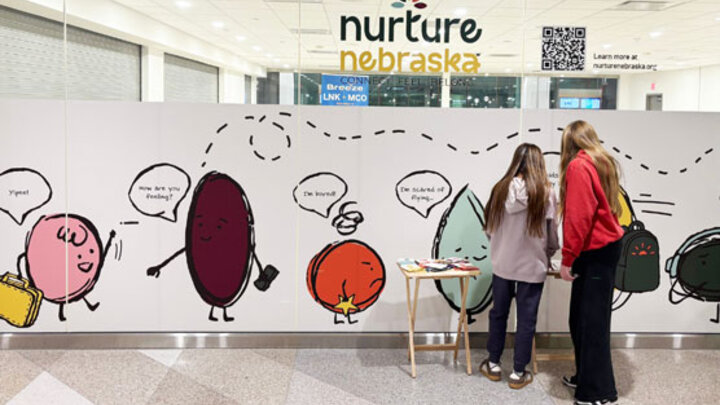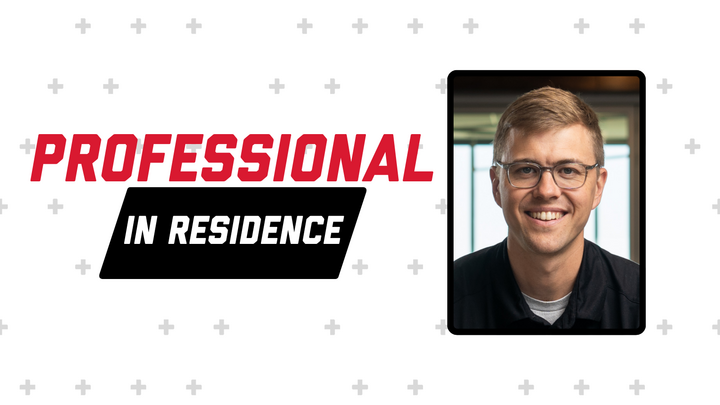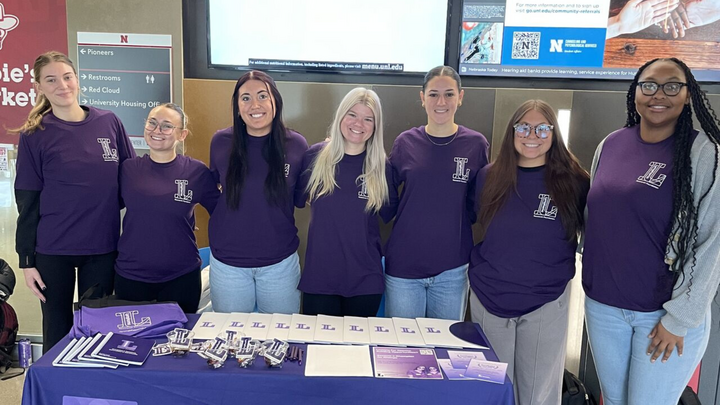The college focused much of its energy in 21-22 on launching a college-wide experiential learning program, The Experience Lab. After the adoption of the strategic plan in May 2021, two co-directors, Assistant Professors of Practice Jemalyn Griffin and Jill Martin were appointed to lead the program. In June 2021, they hired 12 student leads, two for each of the six experience labs: Nebraska News Service, Nebraska Nightly, KRNU, Unlimited Sports, Buoy and Heartland Webzine. An additional four faculty were appointed to serve as faculty liaisons to the program. In fall 2021, 56 students enrolled in the Experience Lab, which grew to 80 in spring 2022.
The college also recruited 13 professionals-in-residence (PIR) to provide mentorship and guidance to Experience Lab students in the fall and 17 in the spring. Their employers donated the PIR's time, so no one was asked to volunteer personal time. One of the PIRs, Keri Mesropov, President of TRG Arts, was recruited to provide leadership training to the student leads. She successfully conducted training in both the fall and spring semesters.
To support the Experience Lab, the college secured a five-year lease for 13,000 square feet on the third floor of the Lincoln Children’s Museum to house the advertising and public relations experiences, now known as The Agency. 14 industry sponsors were secured to provide annual donations toward the cost of the lease and design and furnish rooms within The Agency that reflect the look and feel of the sponsor’s professional environment.
With a sponsorship from Pepsi, the college also renovated an existing television studio in Andersen Hall to create a learning lab for Unlimited Sports. With donations from the Don and Lorena Meier Foundation and the Nebraska Broadcasters Association, the college completed the design and bidding process for a new 3,100 square foot three-set television studio and newsroom in Andersen Hall. Construction on the studio started in May 2022.
To promote and share the Experience Lab with prospective students, alumni, donors and industry partners, the college created a central web portal that links all the Experience Lab opportunities together and provides access to the individualized content created within each program.
Experiential Learning will be embedded in the college’s curriculum. In spring 22, the college faculty passed a requirement that beginning in fall 2022, all students will be required to complete at least three, but up to six, semesters in the experience lab to graduate with a degree from the college. The college also designated courses throughout our curriculum, including the Experience Lab, Communication Design courses and capstone courses as experiential learning courses to align with the University’s N2025 plan.
|
Aim 1 Targets |
Start (20-21) |
21-22 |
Goal (25-26) |
|
60% of undergraduate majors will be enrolled in or have completed the practicum requirement.[1] |
0 |
13% |
60% |
|
80% of graduating seniors will have a professional portfolio |
0 |
0 |
80% |
|
Increase study abroad participation by 10%[2] |
26 |
|
29 |
|
Increase first-semester freshmen enrollment by 15%[3] |
142 |
147 |
163 |
|
Increase total college enrollment by 10%[4] |
1137 |
1051 |
1250 |
|
Maintain first-year to second-year retention rate above 88.5%[5] |
91.1% |
85.1% |
88.5% |
|
Increase four-year graduation rate from 54.4% to 57% [6] |
57% |
50.3% |
57% |
|
Increase six-year graduation rate from 77% to 79% [7] |
77.6% |
79.5% |
79% |
|
Determine baseline data for internships using senior survey and increase year-over-year numbers [8] |
68.3% |
|
68.3%+ |
|
Increase first destination employment or advanced education rate at graduation from 52.3% to 58%.[9] |
52.3% |
75.7% |
58% |
[1] The figure was calculated by dividing the official college enrollment (1051) by the total Experience Lab enrollment for the fall and spring semesters (136).
[2] Study abroad participation was provided by the Office of Education Aboard. The 21-22 figures will not be available until after the summer 2022 sessions are complete.
[3] First-generation enrollment is obtained from the Academic Services and Enrollment Management Master funnel fall semester reports.
[4] Total college enrollment is taken from the UNL Data Index fall semester reports. The college experienced a decrease in enrollment in between 20-21 and 21-22. This enrollment was likely driven by a decrease in enrollment university-wide due to COVID-19, the suspension of academic probation and dismissal in the College of Business, which feeds students into the CoJMC ADPR major and the largest graduating class in college history in 20-21. Enrollment is showing signs of rebounding with increases in fall 2021 and a 13.5% increase in enrollment deposits paid for fall 2022.
[5] Retention rates are taken from IEA’s Graduation and Retention Rate Report. The 2020-2021 rate is for the 2019 cohort and the 2021-2022 rate is for the 2020 cohort. The college’s 2020-2021 retention rate of 91.1% was likely artificially high due to the University’s decision to halt its normal probation and dismissal processes during the height of COVID-19. The rate of 85.1% is more in line with historical college retention rates and was the highest rate on campus in 21-22.
[6] Graduation rates are taken from IEA’s Graduation and Retention Rate Report. The 2020-2021 four-year rate is for the 2016 cohort and the 2021-2022 rate is for the 2017 cohort.
[7] Retention rates are taken from IEA’s Graduation and Retention Rate Report. The 2020-2021 six-year rate is for the 2014 cohort and the 2021-2022 rate is for the 2015 cohort.
[8] The internship rate is drawn from the CoJMC Senior Exit Survey and includes all students who listed an internship location. The surveys included in each year are from the fall, spring and summer semesters. The 21-22 data will be available when the summer 2022 senior exit survey is complete. The college’s internship rate was drawn from the CoJMC senior exit survey, which provides space for students to list internships and jobs they’ve had during their college careers. This data collection method lacks precision and leaves the entries open to interpretation by the reviewer. The new student Experience Survey, launched in 2021, should provide more reliable data to gauge student internship participation in future years.
[9] First destination rates are taken from the Career Services FDS UNL report. The data collection methodology employed for the first destination survey has resulted in a significant number of non-responses from graduates in previous years. While the non-response rate has remained consistent across the years, the lack of information provides an incomplete picture of students’ first destination outcomes. In 21-22, the college began supplementing the university’s data collection with manual reviews of LinkedIn information. This manual review resulted in a large increase in the proportion of students with documented jobs or graduate enrollment within one year of graduation.



